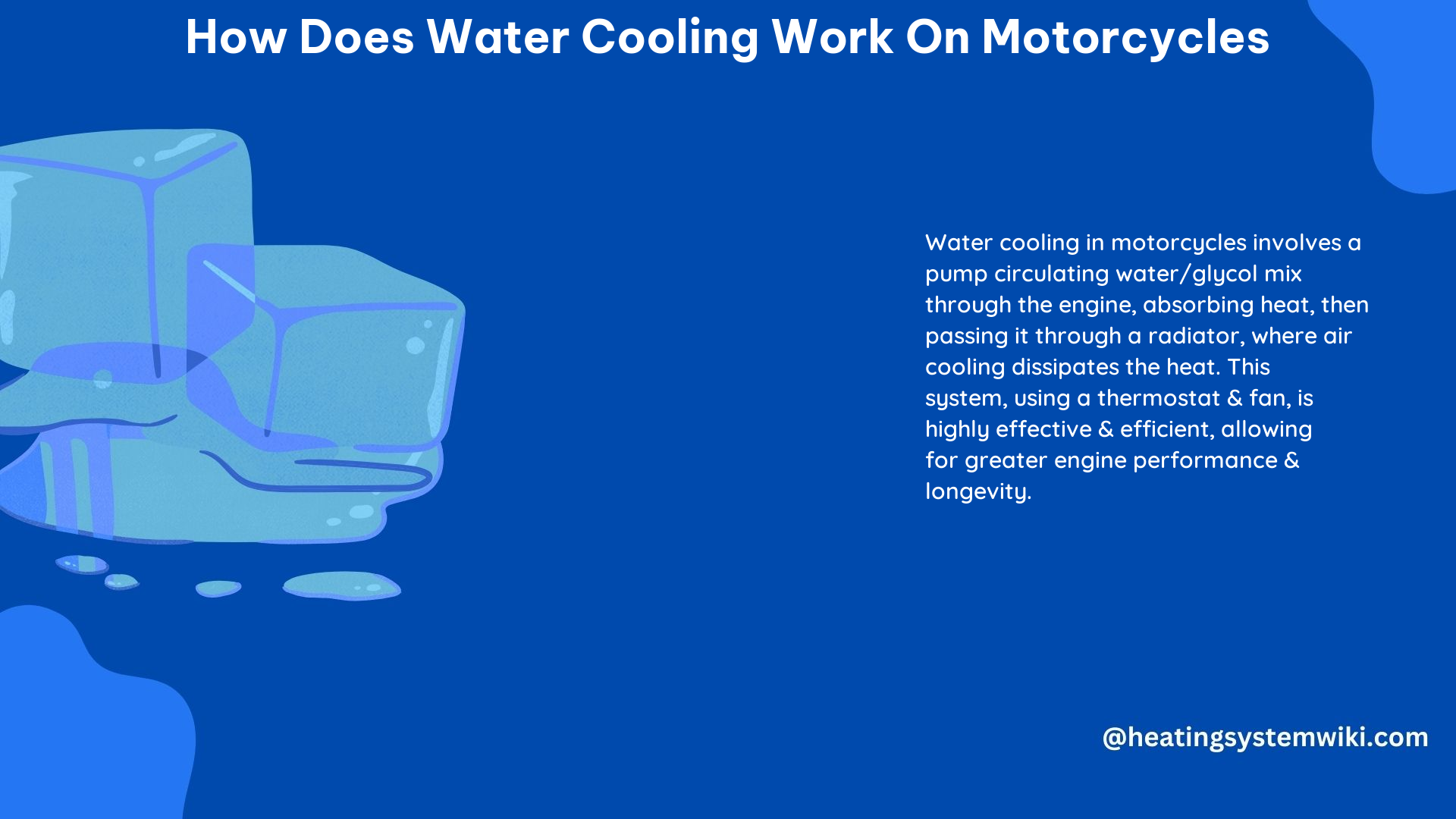Water cooling is a method of cooling an internal combustion engine, including those in motorcycles, by circulating a liquid coolant through the engine block and heads. The coolant absorbs heat from the engine and then passes through a radiator, where it is cooled by air before being recirculated. This process helps to maintain the engine at a consistent temperature, reducing wear and tear and improving performance.
The Water Cooling System Components
The water cooling system in a motorcycle engine typically consists of the following key components:
-
Water Pump: The water pump is responsible for circulating the coolant through the engine block and heads. It is typically driven by the engine’s crankshaft and can have a flow rate of 10-20 liters per minute, depending on the engine size and performance requirements.
-
Coolant: The coolant is the liquid that absorbs heat from the engine and transfers it to the radiator. It is typically a mixture of water and ethylene glycol or propylene glycol, which helps to prevent freezing and boiling. The coolant capacity in a motorcycle engine can range from 1-3 liters, depending on the engine size.
-
Thermostat: The thermostat is a temperature-sensitive valve that regulates the flow of coolant through the radiator. When the engine is cold, the thermostat remains closed, allowing the coolant to circulate through the engine block and heads to quickly reach the optimal operating temperature. Once the coolant reaches the desired temperature, the thermostat opens, allowing the coolant to flow through the radiator for cooling.
-
Radiator: The radiator is the heat exchanger that cools the hot coolant coming from the engine. It is typically located at the front of the motorcycle, where it can receive maximum airflow as the bike is moving. The radiator may have a surface area of 0.5-1.5 square meters and a fin density of 12-18 fins per inch, depending on the engine size and cooling requirements.
-
Cooling Fan: Some motorcycles may also have a cooling fan that helps to draw air through the radiator, especially when the bike is idling or moving slowly. The fan is typically controlled by a thermostatic switch that activates it when the coolant temperature reaches a certain threshold, usually around 80-90°C.
How the Water Cooling System Works

-
Coolant Circulation: The water pump, driven by the engine’s crankshaft, circulates the coolant through the engine block and heads, where it absorbs heat from the engine.
-
Thermostat Regulation: The thermostat monitors the coolant temperature and opens or closes to regulate the flow of coolant through the radiator. When the engine is cold, the thermostat remains closed, allowing the coolant to circulate through the engine block and heads to quickly reach the optimal operating temperature.
-
Radiator Cooling: The hot coolant flows through the radiator, where it is cooled by the air passing over the radiator fins. The cooled coolant then flows back to the engine, where the process repeats.
-
Fan Activation: If the coolant temperature rises above a certain threshold, the thermostatic switch activates the cooling fan to draw more air through the radiator and help dissipate the heat.
Advantages and Disadvantages of Water Cooling
Advantages:
– Allows for more precise temperature control, which is important for high-performance applications.
– Generally more efficient than air cooling, allowing for smaller and lighter cooling systems.
– Helps to maintain a consistent engine temperature, reducing wear and tear.
Disadvantages:
– More complex and expensive than air cooling systems.
– Risk of coolant leaks, which can be difficult to detect and repair.
– Requires regular maintenance, including checking and replacing the coolant and hoses.
Technical Specifications
- Coolant Capacity: 1-3 liters
- Coolant Flow Rate: 10-20 liters per minute
- Radiator Surface Area: 0.5-1.5 square meters
- Radiator Fin Density: 12-18 fins per inch
- Water Pump Rotational Speed: 3,000-6,000 RPM
- Water Pump Flow Rate: 10-20 liters per minute
Installing a Water Cooling System
Installing a water cooling system on a motorcycle can be a complex and time-consuming process, requiring the removal of the engine and the installation of the necessary hoses, pumps, and radiators. It is important to have the right tools and knowledge to ensure a successful installation.
There are many resources available to help with this process, including online tutorials, forums, and instructional videos. It is recommended to consult with a professional mechanic or refer to the manufacturer’s instructions if you are unsure about any aspect of the installation.
Conclusion
Water cooling is a highly effective method of cooling motorcycle engines, providing precise temperature control and improved performance. While it is more complex and expensive than air cooling, the benefits of water cooling make it a popular choice for many motorcycle enthusiasts and manufacturers. By understanding the key components and how the system works, you can better maintain and troubleshoot your motorcycle’s water cooling system.
References:
– How the cooling system works in a motorcycle – YouTube. (2020, April 27). Retrieved from https://www.youtube.com/watch?v=in0ASMC17is
– How Does The Engine Cooling System Work? | Cycle World. (2018, October 19). Retrieved from https://www.cycleworld.com/how-does-engine-cooling-system-work/
– Dan’s Motorcycle “Water Cooling”. (n.d.). Retrieved from http://www.dansmc.com/watercooling.htm
